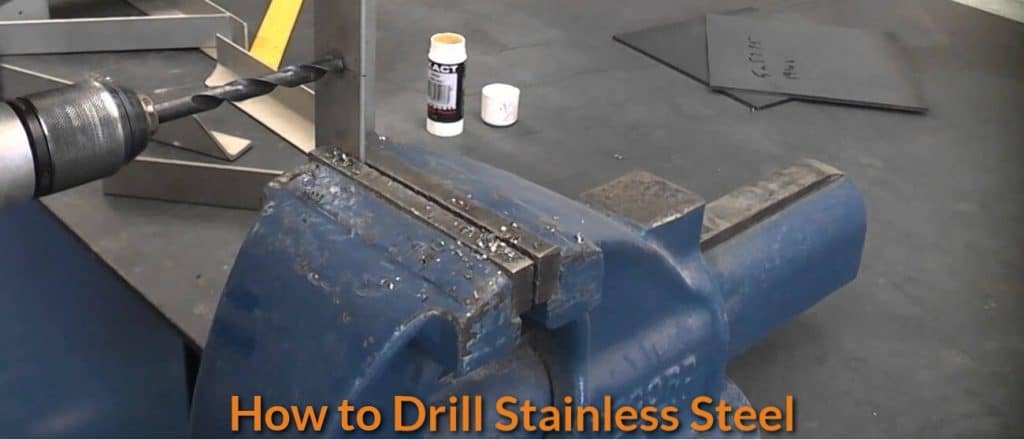June 11, 2021

Stainless steel, also known as “inox steel,” is an alloy of steel with a minimum of around 10.5% chromium, based on its mass. It is known for its corrosion-resistance, high heat resistance, and high ductility. These characteristics of stainless steel make it quite difficult to cut or drill. Although there are different families of stainless steels, some types of stainless steels like those of 304 and 316 are quite difficult to drill.
All stainless steels basically share almost the same properties that provide them with varying machinability. Those stainless-steel types that belong to the families of austenitic and duplex have the tendency to easily work-harden and create built-up edges when cut. The duplex stainless steel, for example, is highly resistant to chipping due to its greater level of strength.
Selecting a Drill Bit for Stainless Steel
If the heat of the drill remains or stays on the drill, there is a strong likelihood that the machine itself will eventually break down due to overheating. Moreover, when using high-speed steel drills, the buildup of heat will cause the drilling machine to lose its very own hardness. When using a solid carbide drill, for example, you would readily see microcracks on the edges of the cutting tool. This will eventually cause the drilling tool to fail miserably.
Pressure and Speed
There are basically two factors that you must carefully balance when drilling stainless steel, namely: speed and pressure. When drilling stainless steel, you need to slowly drill to permit the drill bit to find its own working speed. Too much friction may cause your drill to overheat, and if this happens, you may ruin your drill and the stainless steel. You should carefully balance the pressure that you apply. If you apply more pressure, you can cause the drill to stay a bit cooler while it moves through the metal. As you break through, you should lessen the pressure for the best result.
If the speed of the drill, however, is too slow, there is a strong likelihood that the drill will simply rub with the material. This will produce a hardened zone. Afterward, if you go on with that speed, you may end up having a broken drill. On the other hand, if you apply too much speed, the contact between the drill bit and the stainless steel’s surface will engender too much heat. This will also lead to drill failure.
Pressure and Feed Rate Control
The tactic when drilling stainless steel is to strike a balance between pressure, feed rate, and speed. Feed rate control is crucial to proper chipping. The feed must be high so that the cutting edge could cut through the workpiece. If the feed rate is too low, the rubbing between the bit and the workpiece will be inadequate to create proper chip break. Moreover, this will only create a work-hardened zone which may end in a premature breakdown of your drill. If the feed is too high, on the other hand, very heavy chips may be produced that don’t break. Furthermore, too high feed rate can readily compromise the integrity of the drill and may lead to drill failure.
Removing the Drilling Chip
When drilling stainless steel, you may freely let the drilling chips get away from the hole that you are drilling. The reason for this is that any buildup of chips within the hole can cause roughness along the wall of the hole. It may also cause clogging of the hole that may eventually lead to drill breakage.
On and Off Drilling
It is a protocol that whenever you are drilling, you need to let the metal and the drill bit to cool down a bit before starting to drill again. This is necessary because overheating may occur if you would not give the drill bit and the metal a respite. The trick is quite simple, and those who are already experts in using a drill know how to find the sweet spot wherein the bit, drill, and the metal readily work together.
You need to be sensitive to the feeling of the bit, metal, and drill. If you feel that it is giving off too much smoke, stop immediately. Let the metal cool for a minute before you proceed again. In this way, you can inevitably prolong the lifespan of your drill while also prolonging the integrity of your drill bit. As a rule, the larger the hole you are drilling, the slower you should drill to reduce the buildup of heat.
Conclusion:
Patience is essential when drilling stainless steel. You can’t simply apply too much or too low pressure. Your feed rate should also strike a balance to find the sweet spot. Moreover, you should allow the material, bit, and drill to cool down before proceeding. You would get the hang of it as you become more experienced in the process of drilling stainless steel. Lastly, you should not settle for inferior bits. Spend more money on stronger bits to make the drilling process for you cool and easy.
